
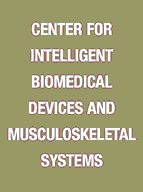
Center for Intelligent Biomedical Devices and Musculoskeletal Systems (IBDMS)
Colorado School of Mines and Rocky Mountain Musculoskeletal Research Laboratories (RMMRL)
A National Science Foundation Industry/University Cooperative Research Center since 1998
Integrating advances from engineering design, smart materials, electronics and micro-sensors and actuators into implants and orthoses will revolutionize the biomedical devices and will bring bionics and intelligent technology into the rehabilitation industry
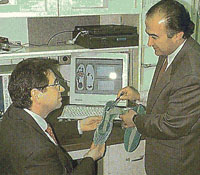
|
Center Mission and Rationale
Over the past three decades, orthopaedic and cardiovascular implants, and, in general, biomedical devices have experienced a major expansion. Recent studies show that 15 million people in the United States have implanted medical devices, and over 400,000 total hip and knee arthoplasties are performed annually. Estimated annual cost for performance of hip and knee procedures is $1.5 billion. Each year, 275,000 cases of hip fracture alone cost as much as $11 million, and annual disability-related payments and healthcare costs are in excess of $170 billion. Current medical research reveals that 10% to 15% of artificial joints have a life span of less than 15 years. Unfortunately, patients requiring two decades or more of use must often undergo another surgical procedure to replace the dysfunctional prosthetic joint. This results in additional discomfort, inconvenience, and additional expense.
The Center for Intelligent Biomedical Devices and Musculoskeletal Systems (IBDMS) brings researchers from engineering and medicine together with leaders from biomedical devices and implant manufacturers to develop the next generation of prostheses that will have a longer life, as well the ability to adapt and interact with the human body to provide a more natural mobility for the patient. [Use Fig. 1 around here]
The IBDMS Center's mission is "... to address issues in joint dysfunction through the introduction of intelligent bioengineering solutions resulting from design optimizing, biomaterials, feedback control, and assistive sensory devices in an effort to decrease risks and increase quality of life in patients suffering from debilitating illnesses. Through innovative research and education, IBDMS will educate a new generation of engineers with interdisciplinary expertise."
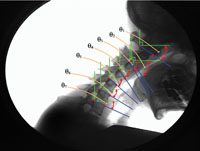
|
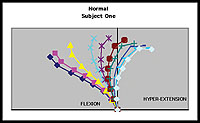
|
Research Programs
The IBDMS Center was established in 1998 with a major focus on lower extremity joints and implants. The Center's research program is composed of the following thrusts:
- Three-dimensional mathematical modeling and simulation of musculoskeletal systems
- Bionic orthopaedics
- In-vivo measurements of joint kinematics [Use Fig. 2 around here]
- Implant engineering and design of orthoses
- Advanced biosensors and signal processing
- Biomaterials research and development
- Monitoring and diagnostic systems
- Artificial sensory and feedback control systems.
The research program of the Center covers nearly every aspect of implant engineering and assistive devices, with an emphasis on mathematical modeling and artificial sensory feedback control. The Center research concentrates on the integration of engineering analysis and design techniques, biocompatible materials, advanced sensors and actuators using MEMs, power electronics and computer engineering, on the one hand, with biology and medicine related to the human musculoskeletal system on the other.

|
A major goal of the Center is to provide state-of-the-art technology and new biomedical devices for its industrial members. The Center's newly developed in-vivo joint motion measurements using fluoroscopic images and automatic modeling fitting process have significantly advanced our knowledge about total knee and hip arthoplasty. They revealed new findings, such as lift-offs at knee and hip joints, which can describe premature failures of implants. [Use Fig. 4 around here IF there's room]
Current Center projects include:
- Determination of the Femorotibial Kinematics of the Normal Knee
- 3-D ACL Retaining TKA Kinematics
- Hip Kinematics Alumina-Alumina vs. Alumina-Polyethylene
- Design and Evaluation of a Self-Powered Telemetric Patella [Use Fig. 3 around here]
- Correlation of Hip Kinematics and Wear Retrievals
- Continued Development of the Motion Tracking Fluoroscopy System
- In-vivo Determination of Kinematics for an ACL-Deficient Knee.
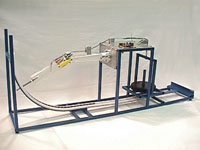
|
Special Center Activities
- State-of-the-art fluoroscopic test facilities for in-vivo investigation of industrial members' implants
- Live surgery classes for industrial members, students, and faculty
- Collaborations with researchers from Japan, Europe, and South America.
The IBDMS Center has become a stepping-stone in reaching and establishing a major alliance for bioengineering in the State of Colorado. Based on a grass-roots effort, the IBDMS Center has been instrumental in bringing together the institutions of higher education with interests in bioengineering to create a unified educational, research and development arm for the State of Colorado. This alliance will expand the research activities of the IBDMS and of its industrial membership.
Center Headquarters
Center for Intelligent Biomedical Devices and Musculoskeletal Systems
Colorado School of Mines
Division of Engineering
Brown Building, Room 330A
1610 Illinois Street
Golden, CO 80401
Tel (303) 384-2033 * Fax (303) 384-2212
Homepage: egweb.mines.edu/ibdms/people.htm
Center Director: Dr. Rahmat A. Shoureshi
rshoures@mines.edu
Center Co-Director: Dr. Richard D. Komistek
rshoures@mines.edu
Center Evaluator: Dr. B.J. Meadows
(303) 420-6157 * bjmeadows@msn.com
NSF 01-168rr